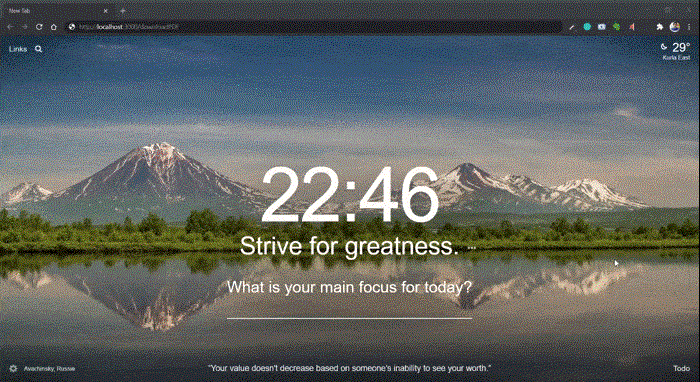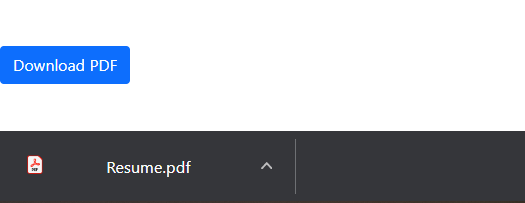如何在express路由响应中发送PDF并强制浏览器下载
在本文中,我们将看到如何在express路由的响应中发送PDF文件,并使浏览器强制下载该文件。
方法:
- 加载所需的包,然后创建一个express应用程序。
- 定义主页和PDF下载请求的路由。
- 创建一个index.html文件,其中包含一个下载PDF的按钮。
- 单击按钮执行ajax请求以获取PDF。
- 在ajax调用的成功回调中,将接收到的PDF文件从blob格式转换为PDF格式。
- 现在,为了使浏览器强制下载PDF:
a. 创建一个隐藏的<a>标签。
b. 使用window.URL.createObjectURL()方法创建文件的引用。
c. 将其href属性设置为blob的URL。
d. 将其download属性设置为文件名。
e. 点击<a>标签。
f. 从DOM中移除该<a>标签。
g. 释放现有的对象URL(对于文件的引用),通知浏览器不再保留文件的引用。
步骤1:安装必要的包
首先,安装以下Node.js包。
npm install --save express
步骤2:创建基本的 Express 服务器设置
创建一个名为 app.js 的文件,并按照下面所示的代码进行编写。
App.js
// Load necessary packages
const express = require("express");
// create an express app
const app = express();
// define PORT number to listen to the requests
const PORT = process.env.PORT || 3000;
// to serve files from uploads directory
app.use("/uploads", express.static("uploads"));
// express routes
app.use("/", require("./routes"));
// listen to requests
app.listen(PORT, () => console.log(`Server started running on PORT ${PORT}`));
步骤3:为应用程序定义路由
创建一个名为 routes.js 的文件,并按照下面显示的代码进行编写。
routes.js
// Load necessary packages
const express = require("express");
// express router
const router = express.Router();
// respond with index.html when a GET request is made to the homepage
router.get("/", (req, res) => {
res.sendFile(__dirname + "/views/index.html");
});
// route for handling PDF request
router.get("/downloadPDF", (req, res) => {
res.download("uploads/Resume.pdf");
});
// export router middleware and use it in app.js
module.exports = router;
步骤4:运行服务器
现在使用以下命令启动你的express服务器:
node app.js
步骤5: 打开浏览器并输入URL
打开您喜爱的浏览器,在地址栏中输入 http://localhost:3000/downloadPDF 然后按下回车键,Resume.pdf 文件将自动下载。
输出:

步骤6:通过按钮使PDF可下载。
您可以通过在按钮上添加点击事件监听器,然后使用ajax请求上面的URL,使浏览器在点击按钮时下载PDF文件。
要在按钮点击时下载PDF文件,首先创建一个包含以下内容的 index.html 文件:
index.html
<!DOCTYPE html>
<html lang="en">
<head>
<meta charset="UTF-8" />
<meta http-equiv="X-UA-Compatible" content="IE=edge" />
<meta name="viewport"
content="width=device-width, initial-scale=1.0" />
<link
href=
"https://cdn.jsdelivr.net/npm/bootstrap@5.0.0-beta3/dist/css/bootstrap.min.css"
rel="stylesheet"
integrity=
"sha384-eOJMYsd53ii+scO/bJGFsiCZc+5NDVN2yr8+0RDqr0Ql0h+rP48ckxlpbzKgwra6"
crossorigin="anonymous"
/>
</head>
<body>
<div class="container">
<button id="download" class="btn btn-primary my-5">
Download PDF
</button>
</div>
<script src=
"https://code.jquery.com/jquery-3.6.0.js"
integrity=
"sha256-H+K7U5CnXl1h5ywQfKtSj8PCmoN9aaq30gDh27Xc0jk="
crossorigin="anonymous">
</script>
<script src=
"https://cdn.jsdelivr.net/npm/bootstrap@5.0.0-beta3/dist/js/bootstrap.bundle.min.js"
integrity=
"sha384-JEW9xMcG8R+pH31jmWH6WWP0WintQrMb4s7ZOdauHnUtxwoG2vI5DkLtS3qm9Ekf"
crossorigin="anonymous">
</script>
<script>
("#download").click(function (e) {
.ajax({
type: "GET",
url: "/downloadPDF",
xhrFields: {
// specify response type as "blob" to handle objects
responseType: "blob",
},
success: function (data) {
// creating a hidden <a> tag
var a = document.createElement("a");
// creating a reference to the file
var url = window.URL.createObjectURL(data);
// setting anchor tag's href attribute to the blob's URL
a.href = url;
// setting anchor tag's download attribute to the filename
a.download = "Resume.pdf";
document.body.append(a);
// click on the <a> tag
a.click();
// after clicking it, remove it from the DOM
a.remove();
// release an existing object URL which was previously
// created by calling URL.createObjectURL()
// once we have finished using an object URL, let the
// browser know not to keep the reference to the file any longer.
window.URL.revokeObjectURL(url);
},
error: function (result) {
alert("error");
},
});
});
</script>
</body>
</html>
输出:

 极客教程
极客教程